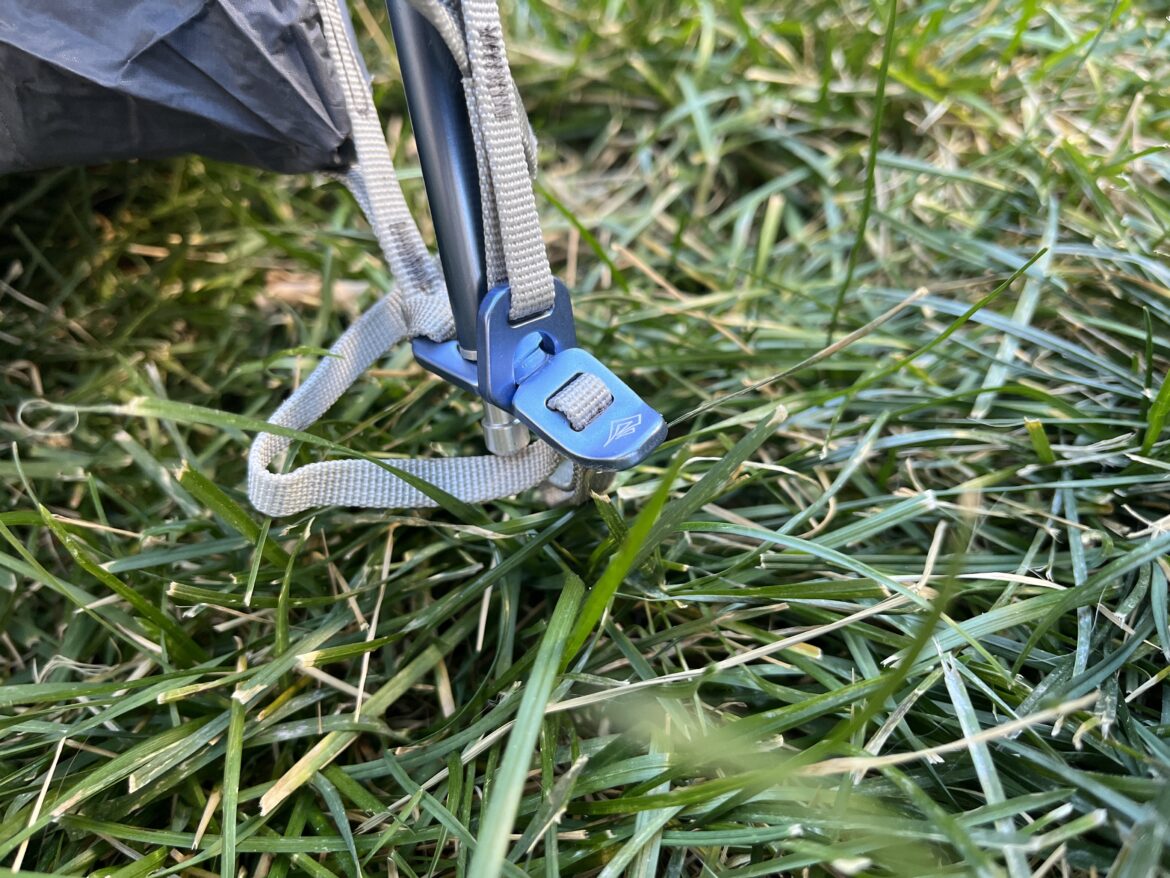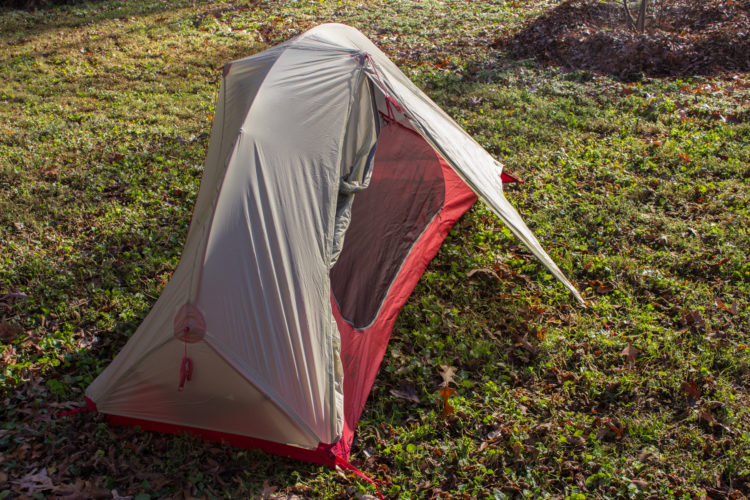
As a friend and I lay next to each other in our sleeping bags in the Sea to Summit Telos TR2 tent, he browsed Amazon and found a handful of small tents that were half the price.
“See, this one is $200.”
“How much does it weigh though?,” I asked him.
“Oh, I see,” he said. The tents he found might have been half or a third of the price, but they were at least twice the weight.
“When it comes to outdoor gear, you’re almost always paying for how light it is,” I told him.
The Sea to Summit Telos TR2 two person tent is no different. There are oodles of two-person tents out there at a fraction of the price, but when you’re bikepacking or backpacking, weight tends to be the primary consideration and that’s where this tent shines.
Sea to Summit Telos TR2 tent specs
- Weight: 3lb 11oz
- 2-person, 3-season
- Price: $599
- Buy from Sea to Summit and REI.

About the Sea to Summit Telos TR2 tent
The Sea to Summit Telos TR2 is one of the lightest tents on the market but is full of other thoughtful design elements. Sea to Summit engineered the tent for head and shoulder space while inside and the designer made the doors high for easy entry and exit.
The Telos TR2 includes color-coded DAC aluminum poles, aluminum hardware, and lightweight tent stakes. The rainfly is seam-taped and coated with polyurethane, and can be converted into Hangout Mode, making it a semi-open shelter, kind of like a lean-to, for those trips when you want some shade but don’t want to lay in the tent.
There is a door on either side of the tent. The canopy, which takes up most of the tent, is made from a polyester mesh, and the floor and rain fly are made from a ripstop nylon. Sea to Summit calls the Telos TR2 a 3-season tent.
The packed weight is 3lbs and 11oz according to Sea to Summit. With everything packed into both dry bags with the Voile straps, ours weighed 4lb and 4oz–about a pound more than Sea to Summit’s advertised minimum trail weight.
There may be better ways to carry the tent while bikepacking, but real estate is hard enough to come by. Sea to Summit’s dry bags are outstanding, but all told, four-and-a-half pounds has some heft to it. Fortunately if you’re going with a partner, each can halve the load since one bag holds the tent and poles and the other holds the fly and stakes, though it may be hard to split that weight evenly.
MSRP for the Telos TR2 tent is $599.

On the trail
Before I dug into this tent, I didn’t realize that “tent architecture” was a field, but I was wrong. As a reviewer I think of product designers as engineers, but architect does have a ring to it, and since a tent designer is someone who is crafting a portable shelter in which people sleep, the architect title makes sense. The brand partnered with Jake Lah, whom they describe as “the father of modern tent architecture.”
Lah’s company DAC supplies the Telos tent poles and he designed other features like the quick connect pole feet. These are nicely machined clips to connect the rainfly quickly.
Lah’s other big design element on the Telos TR2 is the Tension Ridge pole structure, and is the most confusing part of setup if you try to rely on past tent setup experience. Rather than the poles angling downward from a peak, the poles peak on both sides of the tent and drop in the middle. This creates more head and shoulder room for each camper, higher doors, and more usable space in the vestibule.
I accept the blame for not trying to assemble the tent before taking it into the middle of nowhere. But there are only so many ways a tent can be assembled, so after we tried the wrong way first, we reviewed the instructions and discovered the correct way to assemble the Tension Ridge. Then we were flying high. The color-coded poles with the straps take much of the guesswork out. They also have a more trustworthy feel than carbon tent poles which can splinter and crack over time. The rain fly tensioned easily with the straps giving it a secure feel for the weather we had on the way.


Our first night in the tent was as smooth as butter. We cooked some food, set up our sleeping gear and stowed our packs and gear in the roomy vestibules.
Cargo space is plentiful in the Telos with wrap-around pockets near your head, so you don’t have to play guessing games with your phone and headlamp.
The next day when we woke up, we exited the tent and a grey mass of cloud and drizzle had overcome our tent and would be sitting with us for the entirety of the day. By that afternoon we were confined to a horizontal position and watched as rain pooled around the tent’s upper vent in the rainfly, seeped through the zipper, and slowly dropped onto our heads.
It wasn’t a lot… but one way to make camping in a rainstorm worse is to have water enter your tent. Aside from this slow drip, we didn’t have any issues with water entry during what was a very wet 24 hours in the outdoors.
We consulted Sea to Summit about the leak and they inferred that the vent should have been open to mitigate condensation in the tent. This is fair, but both my camp partner and I believe it was rain water entering the zipper based on where it was dripping from, rather than condensation that had formed. Sea to Summit also said the “presence of water droplets on the ‘ceiling’ of the inner tent of the Telos indicates that the corner tensioners have been over-tightened.”
This is worth considering, but the difference between tight and taut feels subjective. It isn’t covered in the instructions, and it’s something many campers will gloss over when they first set up the tent until they are on their backs watching water drip on to their forehead.

Otherwise, the tent worked extremely well for us. We had a fair amount of wind too and flapping nylon is a recipe for insanity when you’re trying to sleep but it was very bearable in the Telos TR2.
It was a comfortable home for a few days in the backcountry and kept us dry during a 24-hour rainstorm. The dripping water wasn’t enough to soak us, but more of a minor annoyance. The roomy vestibules covered our gear well enough. I’d happily sleep in the Telos TR2 again.


Pros and cons of the Sea to Summit Telos TR2 tent
Pros
- Very light
- Easy to attach to a mountain bike with included dry bags
- Sturdy in stormy weather
- Compact but roomy enough
- Good ventilation
- Stays (mostly) dry in rain storms
- Aluminum poles
Cons
- Footprint not included
- Expensive compared to comparable tents
- Design can lead to water inside the tent if the camper isn’t very careful
Bottom line
The Sea to Summit Telos TR2 is a lightweight bikepacking and backpacking tent with a design that can fend off weather and keep campers happy.
- Price: $599
- Buy from Sea to Summit and REI.



















